Purple flowering trees are a wonderful way to add elegance to the outside of your home. Here are some trees you should consider adding to your garden and their plant hardiness zone, sunlight, and soil needs.
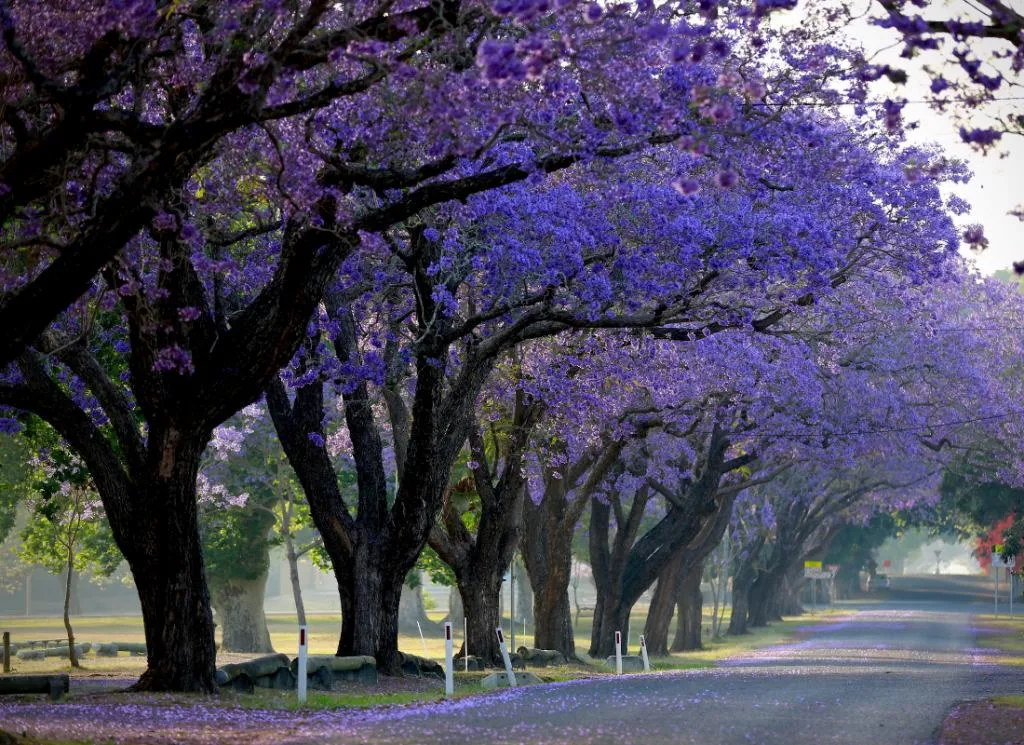
There are many different types of purple flowering trees, and they can be found in various climates. Some of the most popular varieties include the jacaranda, lavender tree, and wisteria tree. Each of these trees has its own unique blooms and fragrance, making them a favorite among gardeners and landscapers alike.
Purple flowering trees are known for their ability to add color and beauty to any landscape. They can also be reasonably easy to care for and tolerate a wide range of environmental conditions. However, choosing the right tree for your particular climate and soil type is essential, as some varieties may not be well suited to your area.
When selecting a purple flowering tree, it is vital to consider the tree’s size, shape, and bloom time. You will also want to consider the tree’s ability to tolerate drought, frost, and wind damage. Once you have considered these factors, you can narrow down your choices and select the perfect tree for your needs.
Types of Purple Flowering Trees
Jacaranda (Jacaranda mimosifolia)

The jacaranda is a fast-growing tree that can reach up to 40 feet in height. It has dark green leaves and spectacular clusters of purple flowers that bloom in the spring.
The jacaranda is hardy in zones 9-11 and prefers full sun to partial shade. It is drought-tolerant but does not like heavy clay soils.
Wisteria Tree (Wisteria sinensis)
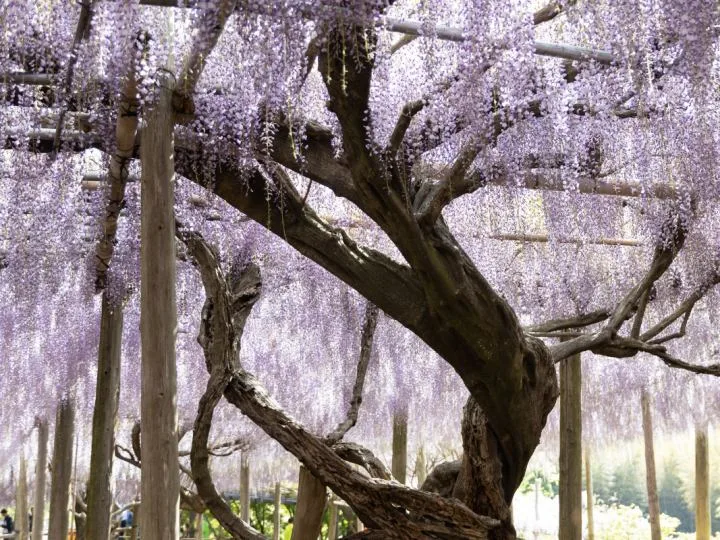
The wisteria tree is a fast-growing vine that can reach up to 10 feet in height. It has dark green leaves and clusters of fragrant purple flowers that bloom in the spring and summer.
The wisteria tree is hardy in zones 4-9 and prefers full sun to partial shade. It is tolerant of many soils but does not like wet or heavy clay soils. As a bonus, this tree is known to be deer resistant.
Catawba Crape Myrtle Tree (Lagerstroemia indica ‘Catawba’)

Crape myrtle is a purple-flowering tree that can reach up to 15 feet. It has dark green leaves and clusters of deep purple flowers that bloom in the spring, summer, and fall.
Crape myrtle is hardy in zones 7-9 and prefers full sun. It is tolerant of many soils but does not like wet or heavy clay soils.
Lilac Bush (Syringa vulgaris)

The lilac bush is a shrub that can reach up to 10 feet in height. It has dark green leaves and clusters of fragrant purple flowers that bloom in the spring.
Although this is meant to be a tree roundup, these bushes are quite tall and give a similar look to that of a tree.
The lilac bush is hardy in zones 3-7 and prefers full sun. It prefers well-drained soils but will tolerate a wide range of soil types.
With its beautiful fragrance, it’s no wonder why this purple flowering tree attracts butterflies and hummingbirds. It’s a great choice if you are looking for a pollinator-attracting plant.
Bloomerang® Lilac Tree (Syringa ‘SMSJBP7’ PP26549)
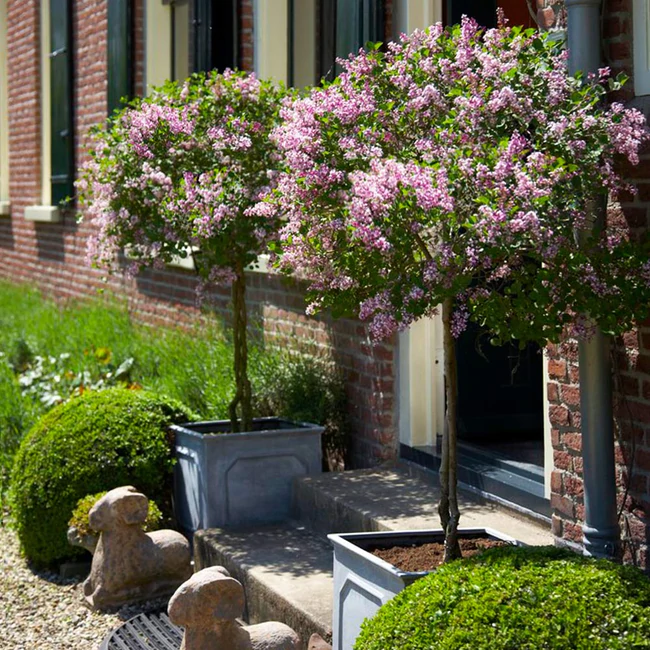
The Bloomerang Lilac Tree is a beautiful little tree that can reach up to 7 feet. It has clusters of little lilac flowers that bloom twice a year.
The Bloomerang is hardy in zones 3-7 and prefers full sun. Consider adding this tree to your front porch in a pot.
True Blue Butterfly Bush (Buddleia ‘Bostulu’)

The True Blue Butterfly bush is a drought-tolerant tree resistant to both rabbits and deer. It can reach up to 6 feet and has clusters of rich blue-purple flowers that bloom from spring to fall.
The True Blue Butterfly bush is hardy in zones 5-10 and prefers full sun. It does well in a variety of soils but does not like wet or heavy clay soils. As a bonus, this tree is known to attract hummingbirds and butterflies.
Muskogee Crape Myrtle Tree (Lagerstroemia indica x fauriei ‘Muskogee’)

The Muskogee Crape Myrtle is a tree that can reach up to 30 feet in height. It is one of the faster-growing Cape Myrtle trees for immediate satisfaction.
The Muskogee Crape Myrtle is hardy in zones 6-9 and prefers full sun. You can expect cool lavender flowers for six months of the year.
There is no need to worry if you live in a dryer area as this is a drought-tolerant tree and should be kept in well-drained soils. You won’t even need to water these for areas with regular rainfall once they have matured.
Miss Kim Lilac Tree (Syringa patula ‘Miss Kim’)

The Miss Kim Lilac tree is a deciduous tree that can reach up to 8 feet in height. It has stunning bluish lavender-colored flowers that bloom in May and pale pink blooms in the summer.
The Miss Kim Lilac tree is hardy in zones 3-8 and prefers full sun to partial shade. If you are looking for a tree that looks beautiful year-round, this is the tree to consider. The bright green foliage transitions into a deep purple color once the blooms have fallen and the weather has gotten cold.
Korean Lilac Tree (Syringa meyeri ‘Palibin’)

The Korean Lilac tree can reach up to 7 feet in height. It has clusters of small, deep purple flowers that bloom during the springtime.
The Korean Lilac tree is hardy in zones 4-8 and prefers full sun. This lilac tree is smaller than other varieties, making it a good choice for gardens with limited space. Consider adding this purple tree to your patio by planting it in a pretty pot.
Twilight Crape Myrtle (Lagerstroemia indica ‘Twilight’)
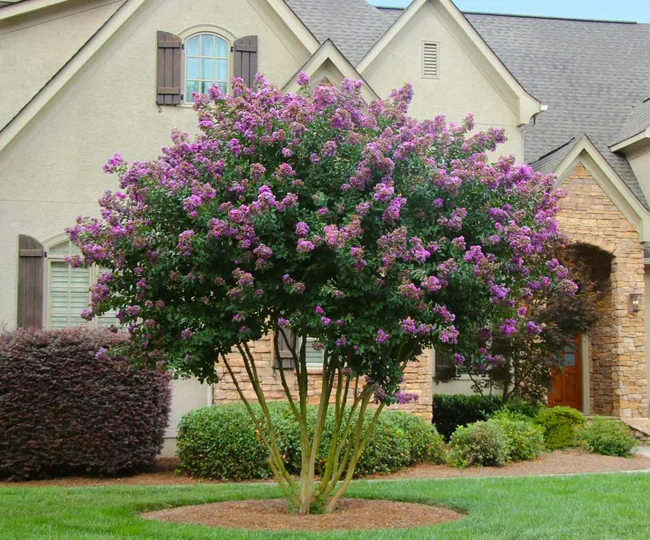
The Twilight Crape Myrtle is a sizeable tree that reaches up to 25 feet in height. Its deep purple flowers bloom from early June until frost.
Adding visual interest, the leaves on this purple flowering tree change from season to season. In the late Spring, you can expect bronze leaves that gradually turn deep green as Summer approaches. Once fall hits, you can enjoy yellow, orange, or even burgundy leaves.
As a bonus, the bark changes from gray to pink to reddish-brown, depending on the season.
The Twilight Crape Myrtle is hardy in zones 7-9 and prefers full sun. It does best in well-drained soils and is drought-tolerant once established.
Lavender Rose of Sharon Althea Tree (Hibiscus syriacus ‘Ardens’)

The Lavender Rose of Sharon Althea tree can reach up to 10 feet. I highly recommend this purple flower tree if you prefer to have a bit of green breaking up your blooms.
The Lavender Rose of Sharon Althea tree is hardy in zones 5-8 and prefers full sun. This tree is tolerant of a wide range of soils, but make sure to plant it in an area with good drainage. You can tell if your tree has been overwatered by checking for yellow leaves.
You can expect your Lavender Rose of Sharon Althea tree to bloom from late summer until autumn.
Red Pixie Lilac Tree (Syringa ‘Red Pixie’)
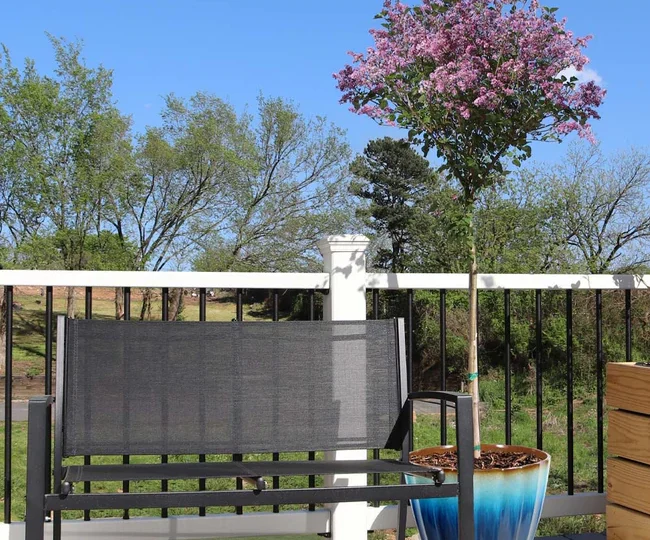
The Red Pixie Lilac Tree is the perfect plant to add to your patio. This dainty tree reaches up to 7 feet tall and has deep red-purple blooms that appear in late spring and last until summer.
Just when you start to miss your pretty tiny flowers, you will find them blooming again in the early fall. You can expect a wonderful mixture of pinkish purple and red blooms.
The Red Pixie Lilac tree grows best in zones 3-7.
Black Diamond® Crape Myrtle – Purely Purple™ (Lagerstroemia indica)
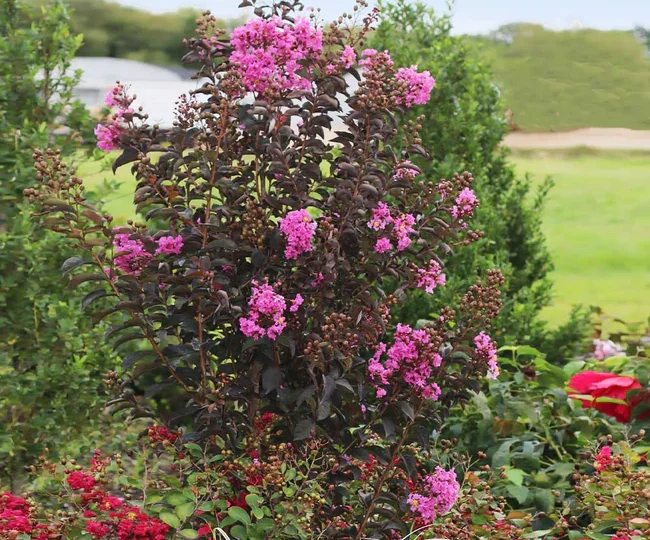
The Black Diamond Crape Myrtle is a tree that can reach up to 12 feet in height. It grows well in zones 6-10 and requires full sun.
Plant this tree in well-drained soil, and once it’s established, it is drought-resistant.
Black Diamond® Lavender Lace™ Crape Myrtle Tree (Lagerstroemia indica’)

This tree is unique because of its gorgeous black foliage that contrasts with pastel purple flowers.
It’s resistant to drought and mildew and grows best with full sun in zones 6-10.
You can expect the Black Diamond Crape Myrtle to be around 10-12 ft at its mature height.
Amethyst King™ Emerald Empire® Crape Myrtle Tree (Lagerstroemia indica)

The Amethyst King Crape Myrtle is a striking tree with lavender flowers and deep green leaves. It grows best in zones 6-10 with full sun.
This crape myrtle can reach up to 20 feet in height, so make sure you have enough space in your yard before planting.
Royal Empress Tree (Paulownia elongate)
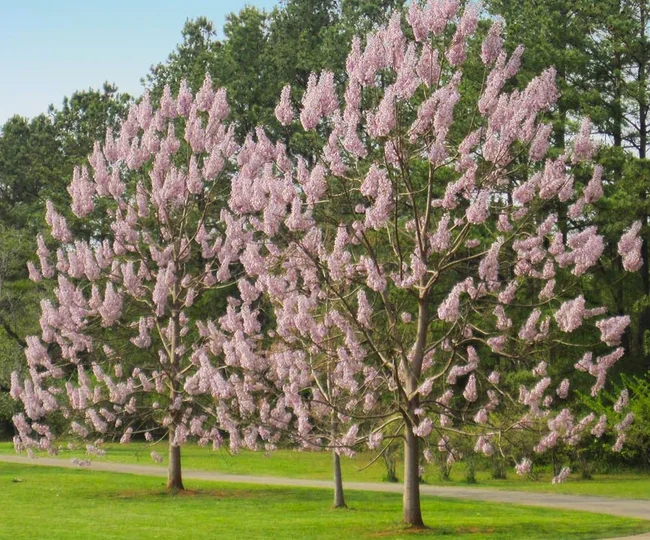
The Royal Empress tree is a fast-growing tree that can reach up to 50 feet in height. You can expect beautiful purple flowers that smell like jasmine and gardenia in the spring.
This tree grows best in zones 7-11 and prefers full sun to partial shade. It’s tolerant of a wide range of soils but prefers well-drained soil. Once it’s established, it’s drought-resistant. It can even grow in toxic soils.
Final Thoughts
Purple flowering trees are a fantastic way to add elegance and beauty to any landscape. With so many varieties to choose from, it is important to select the tree that is best suited for your particular climate and soil type. Once you have found the perfect tree for your needs, you can enjoy its colorful blooms and fragrant blossoms for years to come.
Do you have a favorite tree with purple flowers? Let us all know in the comments!
